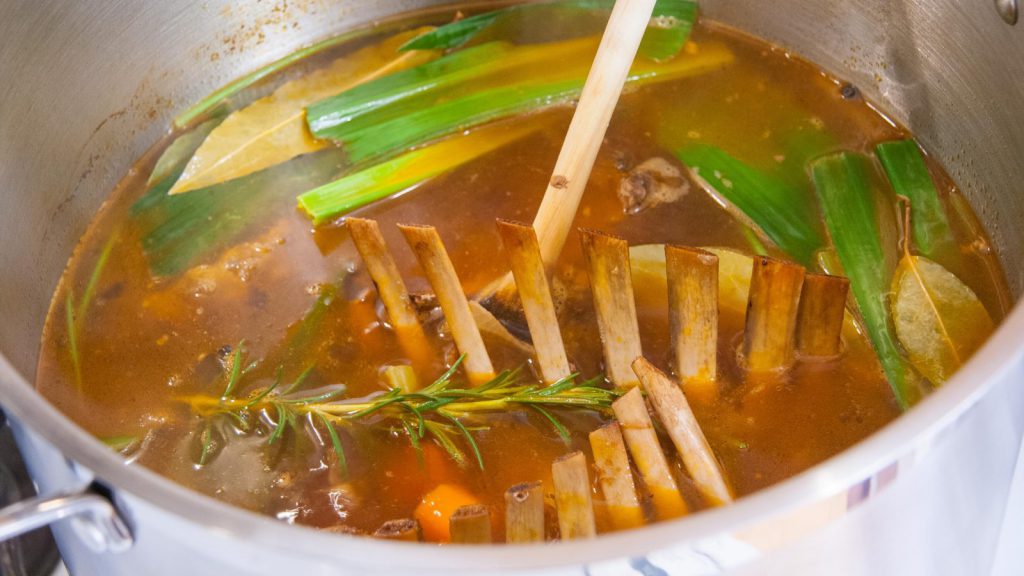Brown Lamb Stock
Brown lamb stock is a rich, flavorful base perfect for sauces, gravies, and stews. It’s made by first roasting lamb bones and vegetables, then simmering them to extract deep, hearty flavors. This stock can be stored in the refrigerator for a few days or frozen for longer storage.
Calories: 981kcal
Ingredients
MAKE ABOUT 2 LITERS (8 CUPS)
- 2 pounds lamb bones
- 1 large onion
- 1 large carrot
- 1 stalk celery
- 1 head garlic cut in half
- 4 tablespoons tomato paste
- 10 whole black peppercorns
- 3 medium bay leaves
- 1 large sprig of thyme
- 1 small sprig of rosemary
- 4 liters water
Instructions
- Heat the oven to 450°F. In a roasting pan, brown the lamb bones for 30 minutes. Turn frequently to cook evenly. Peel and wash the carrot, onion, and celery. Cut the onion in quarters and place in a bowl. Cut the carrot into 1-inch pieces and add it to the onion. Cut the celery the same as the carrot. Add the celery to the bowl and mix.
- Check the oven; the lamb bones should be golden brown. Add both halves of the head of garlic, with the skin on. Remove the bones from the oven. Add Mirepoix and garlic. Reduce the temperature to 380°F. Stir the bones and Mirepoix every 10 minutes, for an additional 30 minutes. Add the tomato paste and cook for 15 minutes.
- Make sure the bones and the aromatic garnish become brown and do not burn. Transfer the bones and the vegetables to a large stockpot. Discard any excess fat (decanter). Put the roasting pan over a burner on high heat and fry. Add 1 liter of cold water (deglaze). Whisk continuously, scraping any residue from the bottom of the pan.
- Pour the liquid from the roasting pan and over the bones in the stockpot. Add the peppercorns, bay leaves, thyme, and rosemary.
- The liquid must cover all ingredients. Bring to a boil and then reduce heat and simmer for a minimum of 3.5 hours. Stir from time to time to ensure nothing is sticking to or burning the bottom. You must keep the bones covered by adding more water during this long cooking process. Strain the stock through a fine strainer.
- Cool and refrigerate overnight. When the stock is cold, the fat will solidify. The stock can be used to make sauces or stews. You can also freeze it if you have leftovers.
Video
Cooking Tips for Brown Lamb Stock
- Roasting the Bones: Roasting the lamb bones in the oven is crucial to developing deep, rich flavors. Ensure they are browned, not burned, by turning them regularly.
- Cold Water for Clarity: Start with cold water to extract the flavors gradually. This results in a clearer stock compared to using hot water.
- Skimming Impurities: Skim the foam and impurities regularly as the stock simmers. This keeps the stock clear and prevents any bitterness.
- Simmer, Don’t Boil: Always simmer the stock gently. Boiling can cause cloudiness and an overly greasy texture, so maintain a low heat.
- Deglazing for Flavor: After roasting, deglaze the pan with cold water to loosen all the flavorful brown bits. These will add depth to your stock.
- Adding Water: Keep an eye on the water level during the long simmering process. Add more cold water as needed to ensure the bones and vegetables stay covered.
- Cooling and Removing Fat: After straining, cool the stock in the fridge. The fat will solidify on top, making it easy to remove for a leaner, cleaner stock.
- Straining for Smoothness: For a smooth, clear stock, strain through a fine-mesh sieve or cheesecloth to remove any remaining small bits of bone or vegetable.
- Herb Adjustments: Customize the bouquet garni to suit your preference. Adding fresh parsley, sage, or additional garlic can elevate the flavor profile.
- Storage: Once cooled, refrigerate the stock overnight to allow the flavors to deepen. Freeze any leftovers for future use.
Master Stock-Making with Our Online Cooking Courses!
Learn to create rich, flavorful stocks—the essential base for soups, sauces, and stews. From vegetable stock to classic brown stock, our expert courses cover all the techniques you need to add depth to every dish.
Stock-Making Courses:
- Stock Making Fundamentals
- Stock Making 101
- White Stocks Making
- Brown Stocks Making
- Vegetable Stocks Making
Ready to elevate your cooking? Start learning at your own pace from home!
🌐 Start Your Culinary Journey Today
For more tips, check out our YouTube Channel and Subscribe for fresh recipes and expert advice!
